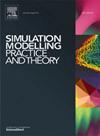Ti-6Al-4V激光粉末床熔合AM过程残余应力和变形的数值预测
IF 3.5
2区 计算机科学
Q2 COMPUTER SCIENCE, INTERDISCIPLINARY APPLICATIONS
引用次数: 0
摘要
增材制造(AM)工艺由于其复杂几何零件的逼真打印而在行业中需求增加。这一过程包括粉末的连续熔化和快速凝固。加热和冷却是导致增材件变形的残余应力的形成。在打印前对变形和残余应力进行预测,可以最大限度地减少由于尺寸变化而导致的零件报废。在本研究中,利用MSC Simufact软件对Ti-6Al-4V材料的LPBF AM过程进行了模拟。仿真结果与已有文献进行了比较。对仿真参数进行了优化,使实验结果与仿真结果的偏差最小。利用固有应变值、体素尺寸等仿真参数预测微拉伸试样的变形和残余应力。在不同方向(0°,30°,45°,60°和90°)和基板位置预测畸变和残差。观察到体素大小(物理层的累积)对预测精度有显著影响。靠近集电箱和气体入口一侧的试样显示出最小的残余应力。与其他取向试样相比,45°取向试件的残余应力最小。由于样品的高度最小,因此注意到0°取向样品的有限畸变。本文章由计算机程序翻译,如有差异,请以英文原文为准。
Numerical prediction of residual stress and distortion for laser powder bed fusion (LPBF) AM process of Ti-6Al-4V
The demand of additive manufacturing (AM) processes has increased in the industry due to its realistic printing of complex geometry parts. The process involves with continuous melting of powder and rapid solidification. The heating and cooling attributes to the formation of residual stress which leads to the distortion in the AM part. The prediction of distortion and residual stress before printing could minimize the rejection of parts due to dimensional variation. In the present research work, an attempt was made to simulate LPBF AM process using MSC Simufact software for Ti-6Al-4V material. The simulation results are compared with the existing literature. The simulation parameters are optimized to minimize the deviation between experimental and simulation results. The inherent strain value, voxel size and other simulation parameters are utilized to predict the distortion and residual stress of a micro-tensile specimen. The distortion and residual are predicted in different orientations (0°, 30°, 45°, 60° and 90°) and at position of the base plate. It is observed that voxel size (accumulation of physical layers) has a significant effect on the prediction accuracy. The specimen placed near the power collector bin and gas inlet side shows minimum residual stress. The residual stress in the gauge section of 45° orientation is minimal compared to other-oriented specimens. The limited distortion is noticed for the 0° orientation specimen as the height of the sample is minimal.
求助全文
通过发布文献求助,成功后即可免费获取论文全文。
去求助
来源期刊

Simulation Modelling Practice and Theory
工程技术-计算机:跨学科应用
CiteScore
9.80
自引率
4.80%
发文量
142
审稿时长
21 days
期刊介绍:
The journal Simulation Modelling Practice and Theory provides a forum for original, high-quality papers dealing with any aspect of systems simulation and modelling.
The journal aims at being a reference and a powerful tool to all those professionally active and/or interested in the methods and applications of simulation. Submitted papers will be peer reviewed and must significantly contribute to modelling and simulation in general or use modelling and simulation in application areas.
Paper submission is solicited on:
• theoretical aspects of modelling and simulation including formal modelling, model-checking, random number generators, sensitivity analysis, variance reduction techniques, experimental design, meta-modelling, methods and algorithms for validation and verification, selection and comparison procedures etc.;
• methodology and application of modelling and simulation in any area, including computer systems, networks, real-time and embedded systems, mobile and intelligent agents, manufacturing and transportation systems, management, engineering, biomedical engineering, economics, ecology and environment, education, transaction handling, etc.;
• simulation languages and environments including those, specific to distributed computing, grid computing, high performance computers or computer networks, etc.;
• distributed and real-time simulation, simulation interoperability;
• tools for high performance computing simulation, including dedicated architectures and parallel computing.
 求助内容:
求助内容: 应助结果提醒方式:
应助结果提醒方式:


